
Aachen Cathedral is a Roman Catholic church in Aachen, Germany and the seat of the Roman Catholic Diocese of Aachen.

Burtscheid Abbey was a Benedictine monastery, after 1220 a Cistercian nunnery, located at Burtscheid, near Aachen, North Rhine-Westphalia, in Germany.
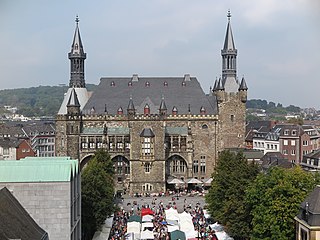
Aachen Town Hall is a landmark of cultural significance located in the Altstadt of Aachen, Germany. It was built in the Gothic architecture style in the first half of the 14th century.
The Proserpina sarcophagus is a Roman marble sarcophagus from the first quarter of the third century AD, in which Charlemagne was probably interred on 28 January 814 in Aachen cathedral. It is displayed today in the Aachen Cathedral Treasury.

The Karlsschrein is located in Aachen Cathedral and contains the remains of Charlemagne. It was completed in 1215 in Aachen at the command of Frederick II, Holy Roman Emperor. Previously, Charlemagne's remains had been in the Palatine Chapel part of the cathedral until 1165, when Frederick Barbarossa placed the remains in a sarcophagus beneath the floor of the cathedral.

The Barbarossa Chandelier was made on the order of Emperor Frederick I, nicknamed Barbarossa, and his wife Beatrice sometime between 1165 and 1170 and was installed under the cupola of the Palatine Chapel in Aachen Cathedral. The chandelier was a donation in honour of Mary, Mother of God, the patroness of Aachen Cathedral and simultaneously represented a tribute to the builder of the cathedral, Charlemagne.

The Marienschrein in Aachen Cathedral is a reliquary, donated on the order of the chapter of Mary around 1220 and consecrated in 1239. Along with the Karlsschrein, the artwork, which is from the transitional period between romanesque and gothic, is among the most important goldsmith works of the thirteenth century.
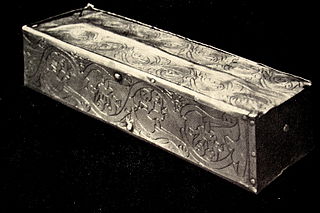
The Noli me tangere casket was a small silver-gilt casket made in 1356 for the Aachen Cathedral Treasury. It measured 15.2 cm in length, 3.7 cm in height and 4.8 cm in width. The casket was kept in the Marienschrein together with the key relics of the cathedral until the nineteenth century and the casket remained in the possession of the cathedral treasury until its destruction during the Second World War.

The Aachen penny of Charlemagne, a Carolingian silver coin, was found on 22 February 2008 in the foundations of the Palatine Chapel in Aachen, during archaeological work in the northeastern bay of the hexadecagon. This is the first discovery of coinage from the time of Charlemagne at Aachen.

The Bust of Charlemagne is a reliquary from around 1350 which contains the top part of Charlemagne's skull. The reliquary is part of the treasure kept in the Aachen Cathedral Treasury. Made in the Mosan region, long a centre of high-quality metalwork, the bust is a masterpiece both of late Gothic metalwork and of figural sculpture.

The Aachen Altar or Passion Altar (Passionsaltar) is a late gothic passion triptych in the Aachen Cathedral Treasury, made by the so-called Master of the Aachen Altar around 1515/20 in Cologne.

The Liuthar Gospels are a work of Ottonian illumination which are counted among the masterpieces of the period known as the Ottonian Renaissance. The manuscript, named after a monk called Liuthar, was probably created around the year 1000 at the order of Otto III at the Abbey of Reichenau and lends its name to the Liuthar Group of Reichenau illuminated manuscripts. The backgrounds of all the images are illuminated in gold leaf, a seminal innovation in western illumination.
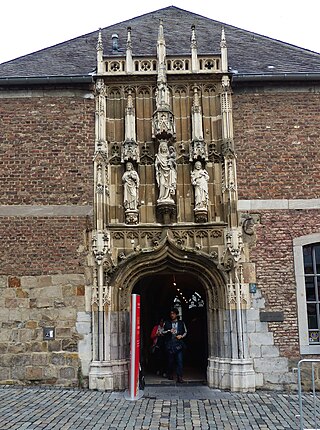
The Aachen Cathedral Treasury is a museum of the Roman Catholic Diocese of Aachen under the control of the cathedral chapter, which houses one of the most important collections of medieval church artworks in Europe. In 1978, the Aachen Cathedral Treasury, along with Aachen Cathedral, was the first monument on German soil to be entered in the List of UNESCO World Heritage Sites. The treasury contains works from Late Antique, Carolingian, Ottonian, Staufen, and Gothic times. The exhibits are displayed in premises connected to the cathedral cloisters.
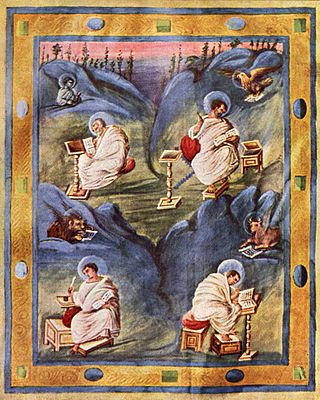
The Aachen Gospels are a Carolingian illuminated manuscript which was created at the beginning of the ninth century by a member of the Ada School. The Evangeliary belongs to a manuscript group which is referred to as the Ada Group or Group of the Vienna Coronation Gospels. It is part of the church treasury of Charlemagne's Palatine Chapel, now Aachen Cathedral, and is today kept in the Aachen Cathedral Treasury. The Treasury Gospels and the more recent Ottonian Liuthar Gospels are the two most significant medieval manuscripts on display there.

The notname Master of the Aachen Altar is given to an anonymous late gothic painter active in Cologne between 1495 and 1520 or 1480 and 1520, named for his master work, the Aachen Altar triptych owned by the Aachen Cathedral Treasury. Along with the Master of St Severin and the Master of the legend of St. Ursula he is part of a group of painters who were active in Cologne at the beginning of the sixteenth century and were Cologne's last significant practitioners of late gothic painting.
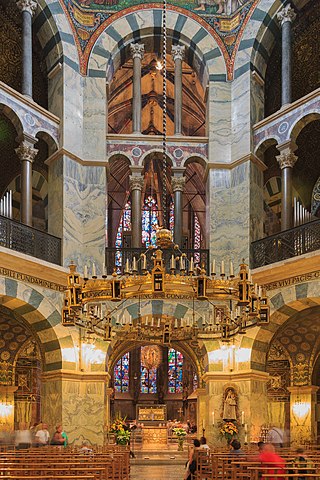
Aachener Domchor is the oldest boys' choir in Germany and one of the oldest in the world. It is based at the Aachen Cathedral in Aachen, a former capital of the Carolingian Empire. The year 782 is given for its founding by Charlemagne and Alcuin of York. Under a succession of directors, the choir gained an international reputation, benefiting from an associated school. Since 2000, the Domchor has been directed by Berthold Botzet.
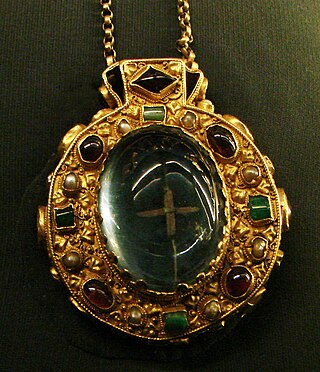
The Talisman of Charlemagne is a 9th-century Carolingian reliquary encolpion that may once have belonged to Charlemagne and is purported to contain a fragment of the True Cross. It is the only surviving piece of goldwork which can be connected with Charlemagne himself with some degree of probability, but the connection has been seriously questioned. The talisman is now kept in Rheims in the Palace of Tau.
"Sei uns willkommen, Herre Christ" is the earliest surviving Christmas hymn in the German language. It originated as a leise and its melody is first recorded as a fragment in the Liuthar Gospels at Aachen Cathedral Treasury, probably dating to the 14th century. The earliest complete surviving version is in a manuscript from Erfurt dating to 1394. August Heinrich Hoffmann von Fallersleben saw the hymn as originating in the 11th century and in 1861 reconstructed a translation from the Erfurt version back into Old High German.
Heinz Hubert Baumann was a German Roman-Catholic priest in Aachen.

Rudolf Pohl was a German Catholic prelate, musician, and choral conductor based at the Aachen Cathedral, where he led the Aachener Domchor to international recognition and revived a school for its boys' choir. He edited sacred music by Johannes Mangon, who had worked at the Cathedral in the 16th century.























